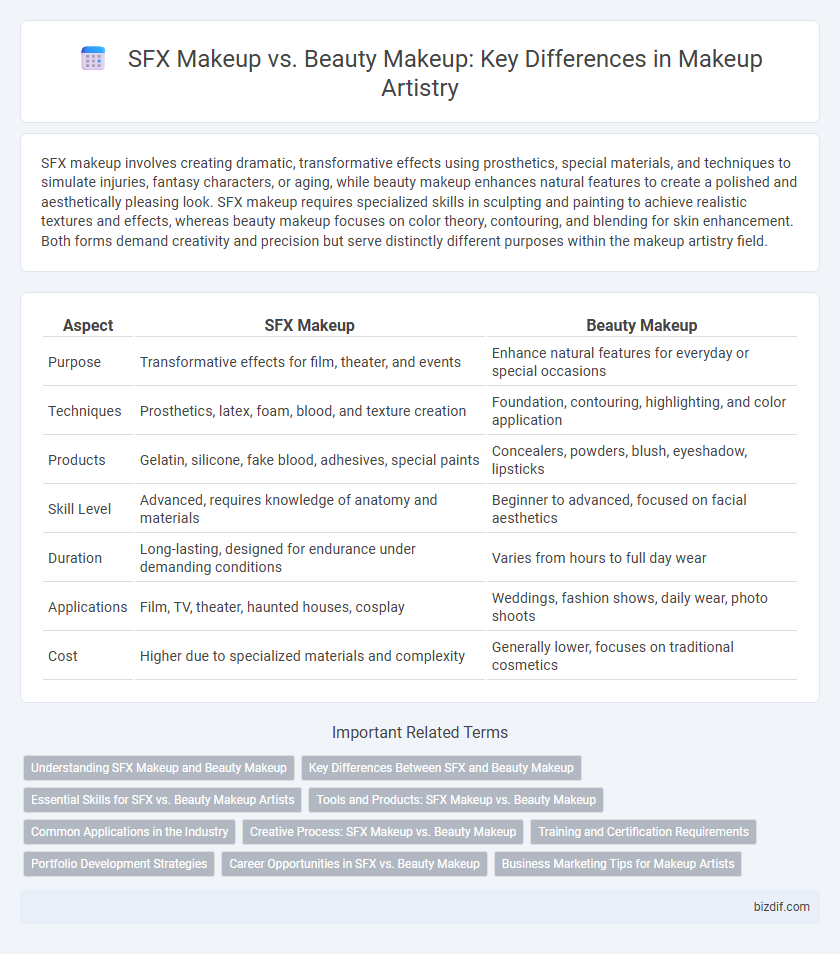SFX makeup involves creating dramatic, transformative effects using prosthetics, special materials, and techniques to simulate injuries, fantasy characters, or aging, while beauty makeup enhances natural features to create a polished and aesthetically pleasing look. SFX makeup requires specialized skills in sculpting and painting to achieve realistic textures and effects, whereas beauty makeup focuses on color theory, contouring, and blending for skin enhancement. Both forms demand creativity and precision but serve distinctly different purposes within the makeup artistry field.
Table of Comparison
| Aspect | SFX Makeup | Beauty Makeup |
|---|---|---|
| Purpose | Transformative effects for film, theater, and events | Enhance natural features for everyday or special occasions |
| Techniques | Prosthetics, latex, foam, blood, and texture creation | Foundation, contouring, highlighting, and color application |
| Products | Gelatin, silicone, fake blood, adhesives, special paints | Concealers, powders, blush, eyeshadow, lipsticks |
| Skill Level | Advanced, requires knowledge of anatomy and materials | Beginner to advanced, focused on facial aesthetics |
| Duration | Long-lasting, designed for endurance under demanding conditions | Varies from hours to full day wear |
| Applications | Film, TV, theater, haunted houses, cosplay | Weddings, fashion shows, daily wear, photo shoots |
| Cost | Higher due to specialized materials and complexity | Generally lower, focuses on traditional cosmetics |
Understanding SFX Makeup and Beauty Makeup
SFX makeup involves creating realistic wounds, scars, and character transformations using prosthetics, latex, and special pigments, emphasizing illusion and theatrical effects. Beauty makeup focuses on enhancing natural features through foundation, contouring, eyeshadow, and lipstick to accentuate attractiveness and style. Mastery of both techniques requires distinct skill sets, tools, and applications tailored to their unique artistic goals.
Key Differences Between SFX and Beauty Makeup
SFX makeup involves creating dramatic, often transformative effects using prosthetics, latex, and special paints to simulate injuries, aging, or fantasy characters, while beauty makeup emphasizes enhancing natural features with foundation, contouring, and color palettes designed for everyday or event looks. SFX artists require specialized skills in sculpting, molding, and materials manipulation, as opposed to the precision and blending techniques prioritized in beauty makeup. The primary distinction lies in SFX's focus on storytelling and character creation compared to beauty makeup's goal of highlighting or correcting facial aesthetics.
Essential Skills for SFX vs. Beauty Makeup Artists
SFX makeup artists require proficiency in advanced techniques such as prosthetics application, sculpting, and airbrushing to create realistic wounds, scars, and fantasy characters. Beauty makeup artists focus on skills like color theory, contouring, and blending to enhance facial features for a polished, natural appearance. Mastery of skin preparation and product knowledge is essential for both disciplines to achieve flawless and durable results.
Tools and Products: SFX Makeup vs. Beauty Makeup
SFX makeup utilizes specialized tools and products such as prosthetics, latex, silicone, and grease paints designed for creating realistic wounds, scars, and fantasy characters, requiring brushes, sponges, and stippling tools for precise application. Beauty makeup relies on foundations, concealers, eyeshadows, and lipsticks formulated for enhancing facial features with a focus on blending brushes, beauty blenders, and fine detail brushes to achieve smooth, flawless skin and defined contours. The difference in product formulations and tool types reflects the unique techniques and effects demanded by SFX versus traditional beauty makeup artistry.
Common Applications in the Industry
SFX makeup is primarily used in film, theater, and television to create realistic wounds, aging effects, and fantastical creatures, enhancing storytelling through visual transformation. Beauty makeup focuses on enhancing natural features for fashion shows, photoshoots, weddings, and everyday wear, emphasizing skin texture, color correction, and contouring. Both disciplines require specialized skills, but SFX makeup relies heavily on prosthetics and materials like latex, while beauty makeup depends on skincare products and cosmetic pigments.
Creative Process: SFX Makeup vs. Beauty Makeup
SFX makeup involves complex techniques such as prosthetics, latex applications, and sculpting to create realistic wounds, aging effects, or fantasy characters, demanding extensive planning and layering. Beauty makeup emphasizes enhancing natural features using color theory, contouring, and blending to achieve flawless skin, symmetry, and radiance. The creative process in SFX makeup prioritizes transformation and storytelling, while beauty makeup focuses on enhancing individuality and aesthetic appeal.
Training and Certification Requirements
SFX makeup requires specialized training in prosthetics, latex application, and character design, often involving certification programs from industry-recognized institutions like Cinema Makeup School or the Make-Up Designory. Beauty makeup focuses on techniques for enhancing natural features, with certification courses offered by organizations such as the Makeup Artists and Hair Stylists Guild or professional cosmetology schools. Both fields demand mastery of hygiene standards, color theory, and application skills, but SFX makeup training typically includes complex anatomy and materials knowledge not covered in beauty makeup certification.
Portfolio Development Strategies
SFX makeup portfolio development requires showcasing diverse skills in prosthetics, special effects, and character transformation through high-resolution before-and-after images and detailed process shots. Beauty makeup portfolios prioritize flawless skin application, trend-driven looks, and versatility across various face shapes, supported by close-up shots that highlight texture and color precision. Including client testimonials and collaboration credits enhances credibility and demonstrates professional experience in both portfolio types.
Career Opportunities in SFX vs. Beauty Makeup
SFX makeup offers diverse career opportunities in film, theater, television, and haunted attractions, specializing in prosthetics, wounds, and fantasy characters, which require specialized skills and creativity. Beauty makeup careers often focus on fashion, bridal, editorial, and commercial work, emphasizing enhancing natural features and trends in cosmetics. Both fields provide unique professional paths, but SFX makeup artists may find more demand in entertainment industries, whereas beauty makeup artists often work closely with clients and brands.
Business Marketing Tips for Makeup Artists
Targeting niche markets distinguishes SFX makeup artists from beauty makeup professionals, enabling focused brand positioning and client acquisition. Utilizing visual portfolios showcasing transformative effects and high-resolution beauty looks enhances social media engagement and online visibility. Collaborating with film, theater, or bridal industries expands networking opportunities and drives diversified revenue streams through tailored marketing strategies.
SFX makeup vs Beauty makeup Infographic

 bizdif.com
bizdif.com